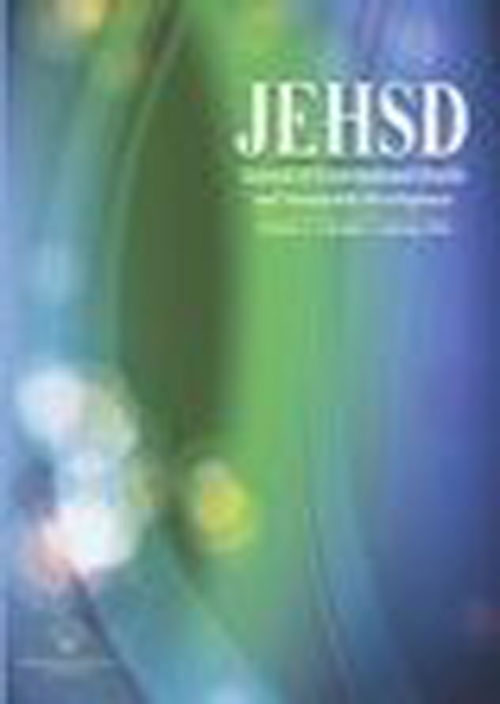فهرست مطالب

Journal of Environmental Health and Sustainable Development
Volume:7 Issue: 1, Mar 2022
- تاریخ انتشار: 1401/01/14
- تعداد عناوین: 8
-
-
Pages 1525-1535Introduction
The use of antiseptics and disinfectants in daily health protocols has a consequence of changing the quality of wastewater to be toxic to microbes. As a result, microbiological wastewater treatment has the potential to not be processed properly. To solve the problem of disinfectant-rich wastewater, a plant-based treatment method can be useful, the implementation of which is a land treatment system for wastewater.
Materials and MethodsThe data collection method was carried out through the Mendeley Reference Manager, searching for articles online, and placing the terms “land treatment system”, and “disinfectant-rich wastewater”. The selected articles were up-to-date and had a significant relationship between the two terms.
ResultsThis sanitation system can be a stretch of land and/or a pond of water, on which plants can grow and process. Normal concentrations of disinfectants for microbial elimination had no negative effects on the growth of various types of plants. Plants continue to live in the stress of water rich in disinfectants, as a condition of their ability to treat wastewater. The involvement of various wastewater treatment media makes evapotranspiration dry bed and evapotranspiration wet bed or wetland ponds capable of processing various pollutants. This approach can be implemented for on-site and off-site sanitation system.
ConclusionIn this context, under conditions of enrichment of disinfectants in wastewater during the COVID-19 era, the land treatment system becomes feasible to solve the problem of changing the quality of wastewater.
Keywords: Disinfectants, Wastewater Treatment, Sanitation, Plants -
Pages 1536-1546Introduction
Accessibility to safe drinking water is an important human health issue, so water reuse and water resources management are critical in arid parts of developing regions. This study aimed to investigate the use of a combined simple designed solar geyser/photocell for drinking water disinfection.
Materials and MethodsIn this study, a solar geyser with a simple design was combined with a solar cell and its efficiency on the disinfection of contaminated water was investigated. This study was carried out with artificially polluted tap water by a solar geyser joined with a solar photovoltaic cell. The heated water (55°C) was kept for 2 hours using a solenoid valve. The pilot plant was operated and monitored for one year. The volume of the collected effluent was measured every 24 h. The most probably number (MPN) of total coliforms and fecal coliforms in 100 mL of 24-hour composed samples were measured.
ResultsThe mean volume of disinfected water production was calculated as 2095.74 ± 270.28 mL/day. The strongest correlation was found between disinfected water and the maximum daily ambient air temperature with a linear model (R2 = 0.9937). The results showed that by increasing the sunny time, the volume of water outlet increased. Therefore, sunny time and UV radiation have direct effect on volume of disinfected water.
ConclusionThe simple designed solar geyser for drinking water disinfection was efficient and recommended for tropical areas, emergency conditions, and farms for agricultural activities.
Keywords: Drinking Water, Water Disinfection, Solar Energy, Photovoltaic Cell -
Pages 1547-1560Introduction
Uncontrolled and improper landfilling of solid waste increases the concentration of heavy metals in the soil. Therefore, this study aimed to investigate soil contamination with heavy metals in the landfill of municipal and hospital waste in Sabzevar city by compiling a map of the severity of heavy metal pollution in the soil.
Materials and MethodsConcentrations of heavy metals were analyzed by ICP-OES at distances of 10, 100 m from the burial site and at depths of 10 and 30 cm. To quantitatively evaluate the severity of pollution and the environmental effects of heavy metals in the soils around the Sabzevar landfill, enrichment factor (EF), index of geoaccumulation (Igeo), and investigating carcinogenic and noncarcinogenic hazards of heavy metals were used. Then a general map of soil pollution severity was prepared using the limitation scores (LS) and potential ecological risk index (RI) method.
ResultsMean concentrations of As, Zn, Pb, Cr, and Cu in topsoil were 6.01, 41.4, 6.31, 26.77, and 31.45 mg/kg, respectively, as well as Hg and Cd were 60.79, and 61.60 µg/kg, respectively. However, mean concentrations of As, Zn, Pb, Cr, and Cu in the soil at a depth of 30 cm were 5.75, 38.33, 6.25, 22.68, and 31.04 mg/kg, respectively, as well as Hg and Cd were 66.57, and 59.98 µg/kg, respectively.
ConclusionAccording to the estimates of Igeo and FE indices, only Hg and Cd showed severe contamination. The noncarcinogenic risks of heavy metals were estimated to be less than 1.
Keywords: Environmental Pollution, Metals, Heavy, Landfill, Cancer, Sabzevar City -
Pages 1561-1570Introduction
Acetamiprid (AP) is one of the most widely used pesticides in the neonicotinoid class. AP residues in the environment have received considerable due to their potential toxicity to humans. Therefore, it is important to remove AP from the aqueous solution.
Materials and MethodsIn the current study, response surface methodology (RSM) was used as an efficient approach to optimize the removal of AP using the electro-Fenton (EF) process. The effects of the main variables, including reaction time, AP concentration, current density, and H2O2 dosage were investigated and optimized. ANOVA technique was also used to identify the Fisher’s value (F-value) and P-value of the model.
ResultsThe predicted AP removal efficiency by the model was in good agreement with the obtained experimental results with correlation regression of 0.98. The ANOVA test proved that the developed quadratic model was significant with very low P-values less than 0.05, the high F-value of 240.1, and regression coefficients close to 1 at a 95% confidence level. The optimum condition for AP removal efficiency of 99.02% was attained at the reaction time of 12 min, AP concentration of 3.5 mg L-1, the current density of 12 mA cm-2, and H2O2 dosage of 86 µL.
ConclusionRSM was employed as a suitable method to optimize the operating condition and maximize the AP removal. Herein, the EF process as an eco-friendly electrochemical advanced oxidation process (EAOP) successfully applied to remove AP from the water and wastewater.
Keywords: Acetamiprid, Advanced Oxidation Process, Pesticide, Water Purification -
Pages 1571-1582Introduction
The increasing trend of petroleum production in Iran and lack of proper and systematic management of waste products in the deposition of petroleum storage tanks have made the existing hydrocarbons as a major hazards to the environment. In this study, the ozonation process was used to remove the petroleum deposits.
Materials and MethodsIn this experimental study, effects of pH, ozone dose, and petroleum hydrocarbons (PHCs) concentration were evaluated. In order to measure the PHCs, using the n-pentanes, the hydrocarbons were first extracted from the environment followed by detection using the GC-FID. The response surface methodology (RSM) was used to evaluate the effect of independent variables on response function.
ResultsIn this study, the efficiency was calculated 45.47% in the optimal conditions of removing PHCs with respect to the optimal energy consumption for the process. Analysis of variance and regression showed that the fitted model had good agreement with the laboratory results.
ConclusionThe results demonstrated that the advanced oxidation process (AOP) of ozone at high pH levels could be a useful method for the degradation and reduction of heavy hydrocarbons in petroleum waste. However, regarding the energy consumption, it is suggested to use less costly reactions as pretreatment or final treatment steps.
Keywords: Oily Sludge, Advanced Chemical Oxidation, Petroleum Hydrocarbons, Response Surface Methodology -
Pages 1583-1593Introduction
Greenhouse gas (GHG) emissions have caused environmental effects. Food production is one of the sources of GHGs. This study aimed to suggest dietary scenarios for decreasing GHG emissions.
Materials and MethodsGHG emissions in the target population of Urmia city, Northwest Iran, were investigated using a modeling approach. Three dietary scenarios were modeled and analyzed to evaluate and compare GHG emissions. The objectives and decision variables of the three scenarios included minimizing the carbon footprint and intake of food items, respectively. In the first scenario, the amount of energy intake was equal to baseline energy intake. The second scenario maintained the same energy intake constraint as the first scenario and made further alterations by considering the number of serving sizes suggested by the food pyramid for each food group. The third scenario was mostly based on this model by accounting for dietary reference intake for macronutrients, micronutrients, and energy.
ResultsThere was about 72% and 55.67% reduction in carbon dioxide equivalent (CO2 eq) production in the first and second scenarios rather than the baseline diet of 4072.10 g CO2 eq, respectively. In the final scenario, the CO2 eq emissions were less than half of the baseline diet.
ConclusionThe study showed that a healthy diet with a higher proportion of vegetables, fruit, legumes, nuts, and dairy, and a lower share of red and white meat, egg, grains, fat and oil, and sweets can reduce CO2 eq emissions.
Keywords: Greenhouse Gases, Diet, Carbon Footprint, Vegetarian, Environment -
Pages 1594-1601Introduction
Gaseous air pollutants can cause oxidative stress, which can lead to lung damage by inducing inflammation. Polymorphisms in the glutathione S-transferase (GST) gene are involved in the pathogenesis of many diseases, including lung disease. Two glutathione S-transferase Mu 1 (GSTM1) and glutathione S-transferase theta 1 (GSTT1) genes belong to this family, in which deletions occur and the resulting alleles are unable to produce active enzymes.
Materials and MethodsIn this study, 41 steel plant workers with impaired lung function were selected. Multiplex PCR technique was used to identify the genotyping of GST M1 and T1.
ResultsThe results of the frequency of gene deletion among 41 patients showed that there were 10 individuals (17.2%) with deletion of GSTM1 gene, 4 individuals (11.8%) with deletion of GSTT1 gene. The results of the frequency of gene deletion among 50 healthy individuals (control group) also showed that there were 8 individuals (8.5%) with deletion of GSTM1 gene, and 12 individuals (8.3%) with deletion of GSTT1 gene. There were 7 individuals (14%) without deletion of GSTM1 and GSTT1 removal. The results of Chi-square test between healthy and sick groups showed no significance at the level of p < 0.05.
ConclusionAccording to the results, it can be concluded that the sensitivity to lung function abnormalities in steel workers is directly related to the duration of employment.
Keywords: Total Lung Capacity, Glutathione S-transferase M1, Air Pollutants, Isfahan City


